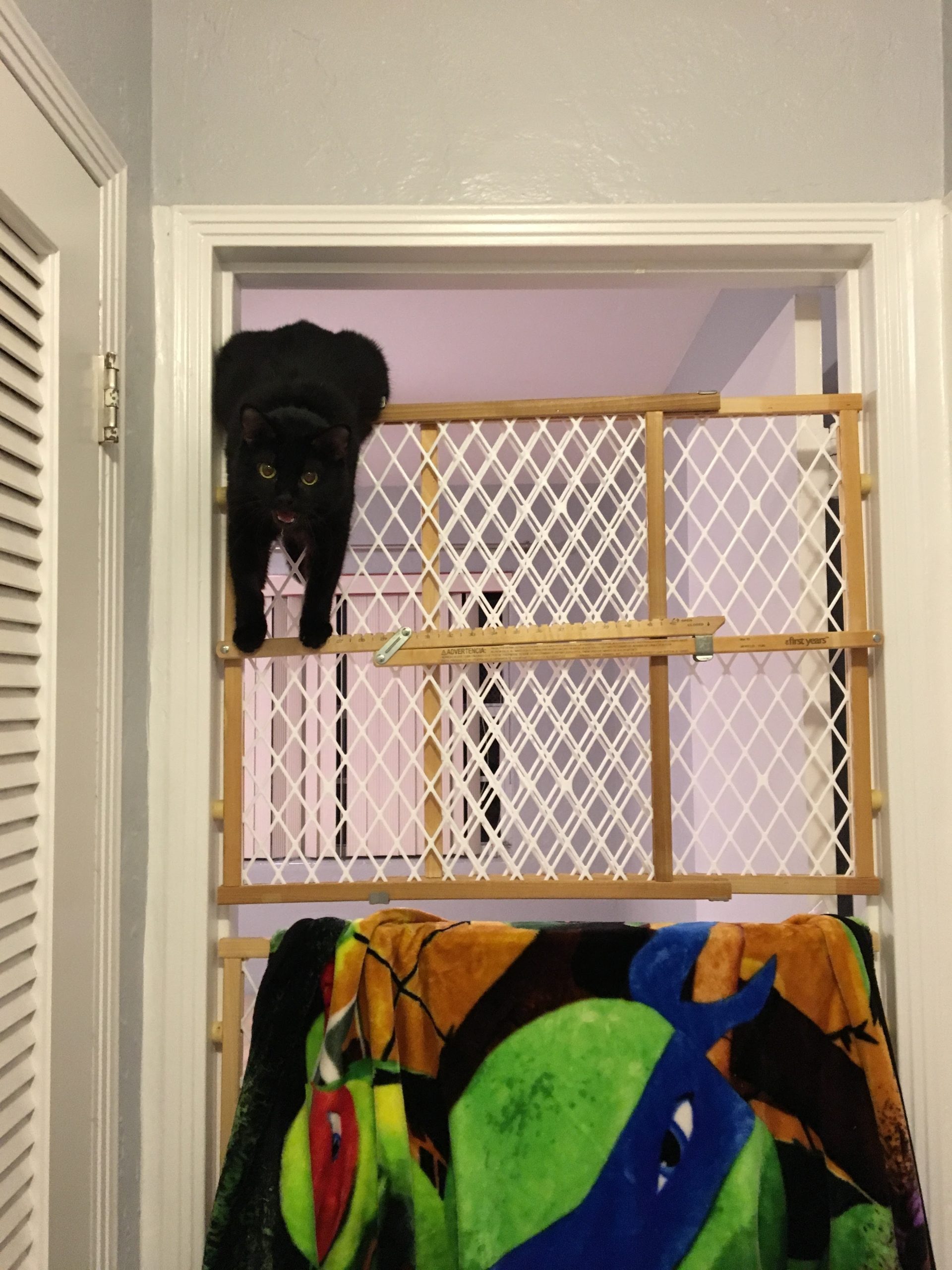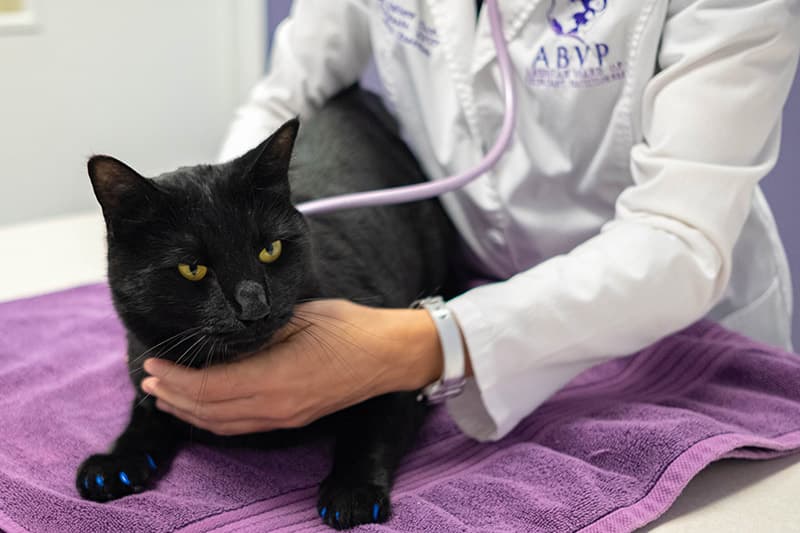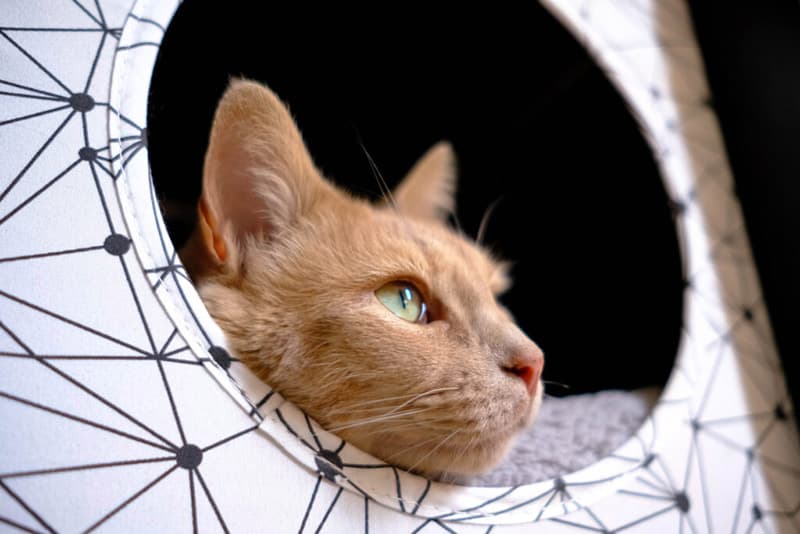From deciphering feline body language to creating a safe environment, using tools like baby gates and pheromone spray, and implementing a gradual introduction process, we will explore all the essential steps for a harmonious multi-cat household.
So, get ready to foster positive relationships between your feline companions and ensure a smooth introduction process by following these top secrets.
But first… DON’T DO THIS…
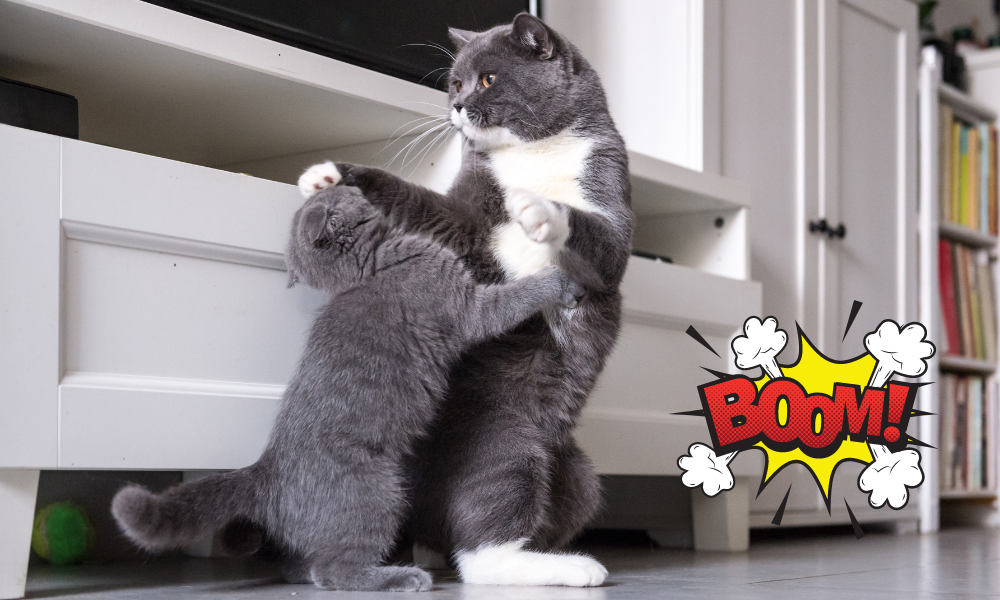
Whether you read this entire article or not, do read the following tips from well-known feline behaviorist Ingrid Johnson on what NOT to do!
- “Do not place the new cat in a carrier and set them on the living room floor where the existing cats can circle (and hiss at) them. This is incredibly stressful and makes the new cats feel like prey. This commonly recommended technique often results in an incredibly negative first encounter.”
- Put yourself in this cat’s position. How horrible would that be?
- “Do not physically restrain the cats with your hands, a harness, leashes, etc. in an effort to force interactions. That is a great way to increase the cats’ stress levels and get yourself injured.”
- What a terrible way to make a first impression!
- “Do not place one cat face-to-face with another cat.”
- A showdown in the corral?
- “Do not just open the carrier and let them go.”
- Or chaos will likely ensue!
Realistic expectations
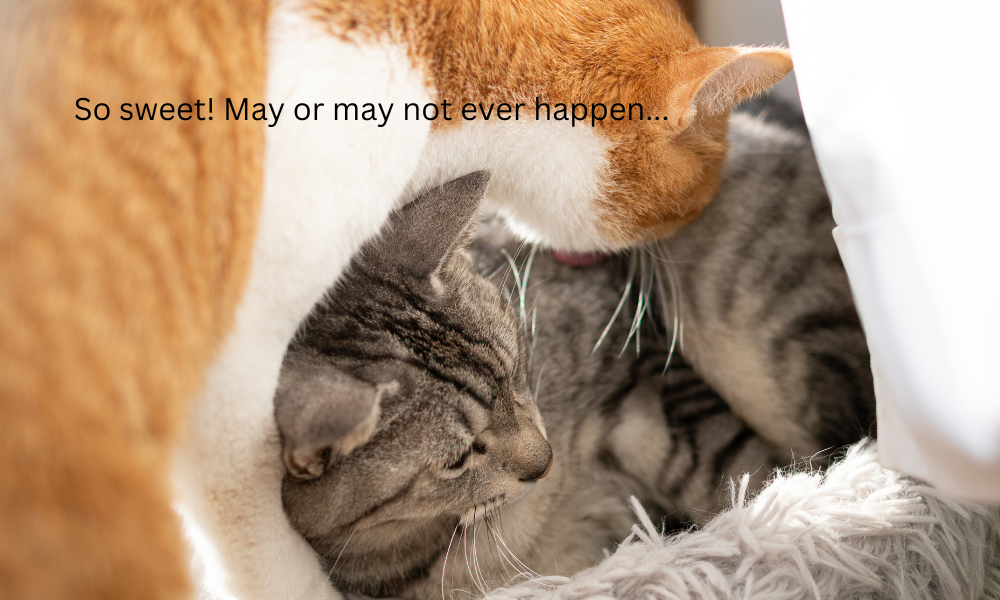
Yes, it would be amazing if every cat in our multi-cat households were BEST friends with EVERY other cat. I’m here to tell you…Probably. Not. Gonna. Happen.
Cats are unique creatures with their own individual personalities, just like us. Imagine if you suddenly had a new roommate that you didn’t get to choose. You may or may not get along with them. If you were a child (i.e. a kitten) when you got said roommate (who was also a kitten), chances are things would turn out just fine. But if you were a grandma who suddenly had a rowdy teen living with her, the possibilities are endless!
I tell my clients that a realistic expectation is for their cats to tolerate each other without overt signs of intercat aggression, conflict and stress.
Understanding feline body language

Understanding Feline Body Language is crucial when introducing cats to each other. Pay close attention to their subtle cues, such as tail movement, ear position, and body posture, to gauge their comfort level and mood. By understanding their body language, you can better anticipate any potential conflicts and adjust your introduction process accordingly to ensure a successful outcome. This will set the stage for creating a safe environment where your cats can thrive together.
Do you already have conflict? Sometimes it’s hard to tell…
Just because the fur isn’t flying doesn’t mean there isn’t stress. If you have already introduced your cats and are experiencing conflict, consult the 2024 AAFP Intercat Tension Guidelines for help, as well as your veterinarian. You may also need to just go back a few steps slow it down a bit.
Top Tips for Successful Introductions
When introducing a new cat, initially isolate him in a separate room with his own food, water, litter box, scratching post and toys. This allows each cat to gradually adjust to the scent and sounds of the other cat. The cats should not be interacting with each other yet. This was Bacon’s set up in my child’s room. He had a blast adjusting to his new surroundings!
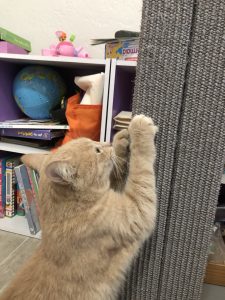
Remember that every time you add a cat, you need another litter box. See my litter box guidelines post for tips. Most importantly, you should have one box for every cat, PLUS another. And you MUST keep those boxes SPOTLESS! See here for my top tips on litter box care.
Of course there are so many litter box choices, but thinking “outside the box” and choosing a clear storage container (without the lid) with a hole cut in the side for entry is a great option.
Once a veterinarian has deemed the cat healthy (including viral testing for FeLV and FIV), AND the new kitty is acclimating well in her isolated environment (i.e. eating, drinking and using the box normally), limited interaction may occur under the door.
Continue the gradual introduction by exchanging bedding, toys and scratching posts. You can also rub one of the cats on their head and cheeks and then leave that cloth in the other cat’s space, or rubbing a cloth alternately on each cat.
In the past, we used to recommend feeding cats at the same time on either side of the closed door. However, we now acknowledge that cats are solitary eaters and this can lead to stress and anxiety as there may be a perceived competition of resources. Therefore, this technique is NO LONGER recommended.
Instead of food, try playing with each cat on either side of the door. Whether with a lure toy or simple brushing / petting, creating these positive interactions around each other will help associate them in a good way!
Next, add a physical and visual barrier
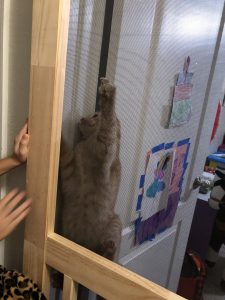 Ok, now you want to do the same steps in terms of playing with them, petting them and providing positive reinforcement that you did above but with a barrier, i.e. something that prevents them from 100% seeing each other (but they still know they are there).
Ok, now you want to do the same steps in terms of playing with them, petting them and providing positive reinforcement that you did above but with a barrier, i.e. something that prevents them from 100% seeing each other (but they still know they are there).
There are many options for these visual barriers. I have personally used 2 or 3 stacked baby gates as well as a wooden screen door purchased from a hardware store. Baby gates work well AS LONG AS you don’t have a climber!
Screen doors also work well, however my most recent introduction (Bacon) scratched right through the screen. The screen door was easy enough to sneak in through the doorway, but a little clumsy when trying to open it just a bit to sneak in.
Initially, you will also want to fasten a towel, sheet, piece of cardboard or other barrier to it to prevent the cats from seeing each other. Eventually, you will start to remove this visual barrier for increasing periods of time.
I recently found this gate setup that looks FANTASTIC! Check out this extra tall cat gate! It has everything you want. The grates are close together so that even a kitten would be unlikely to sneak through. It’s tall. It’s adjustable. There is no mesh to climb. it’s also non-damaging (i.e. no drilling needed. It would be super easy to fasten a piece of fabric to it.
 71" High Extra Tall Cat Gate, 33.85-35.43" Wide Cat Safety Gate, 1.34" Extra Narrow Gap, Auto Close, No Drilling, Double Pet Door for Doorways, Kitchen
71" High Extra Tall Cat Gate, 33.85-35.43" Wide Cat Safety Gate, 1.34" Extra Narrow Gap, Auto Close, No Drilling, Double Pet Door for Doorways, Kitchen
This is now my "Go To" recommendation for introducing cats!
Pro Tip: start with a full barrier (like cardboard or a dark sheet), then move to something a bit more see-through.
NO GATE SCALING LIKE BISCUIT!
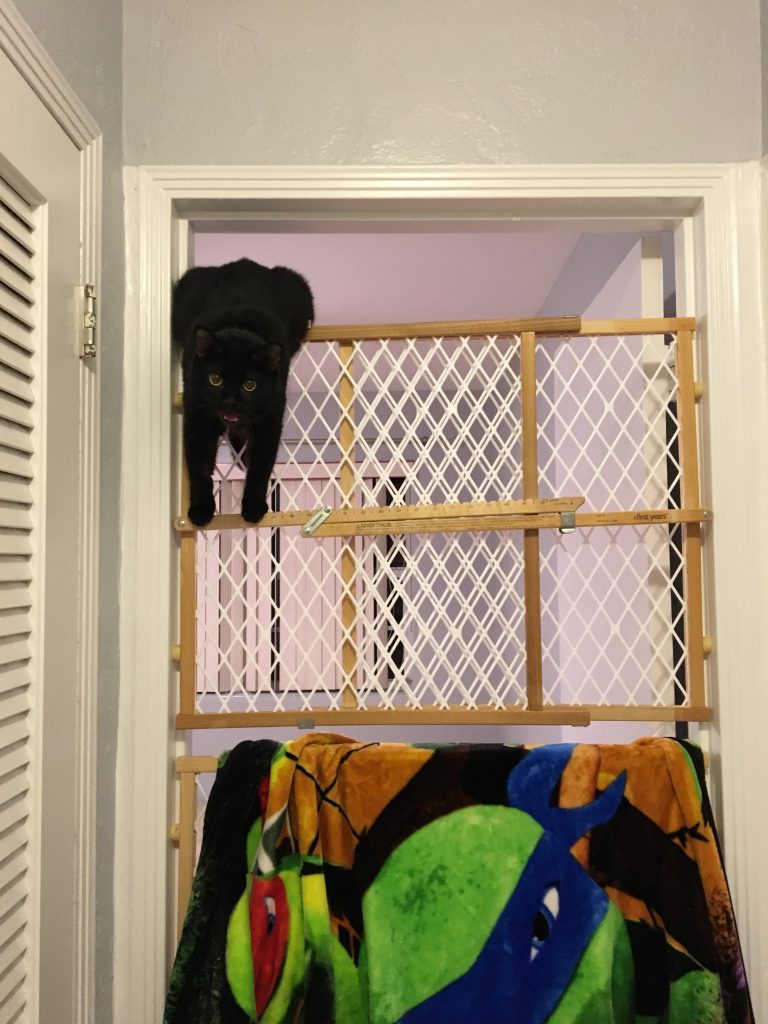
(I “should” have placed a cloth at the top of the frame, visually telling her that she couldn’t get over it).
Now that you have a visual barrier, keep going with the play, petting and positive reinforcement on either side. You may even find the cats rubbing themselves (and especially their faces) onto the barrier.
You can also start to let the cats explore each others’ spaces without direct contact. Allow the new cat to roam the house, checking out litter box setups and all the sights and smells while the current cats are safely secured in a bathroom or bedroom.
Later, put the new cat in the bathroom and allow the existing cats to explore new kitty’s safe zone where he has been staying. There may be some hissing as they investigate who this intruder is, but that should decrease with time.
If all is going well (no hissing or growling), short, supervised, direct interactions can slowly begin. Following this, allow cats to walk around and sniff each other. Continue to reward friendly behavior with treats and praise. Gradually increase the supervised time together. Do not leave the cats together unsupervised until several supervised interactions without aggression have occurred.
How long between each “step?”
The process of introducing a new cat may take several weeks or longer. Older cats may need a quiet space away from kittens for an extended period of time. Friendly, well-socialized cats may adapt to each other rapidly. Follow the cats’ leads!
Pheromones can help!
Pheromone products such as Feliway spray and/or diffusers may ease the introduction, but should be used in conjunction with gradual introduction. bSerene is another product from a trusted company that can be used.
Pheromones can help to calm anxious or stressed cats by mimicking the natural facial pheromones that cats use to mark their territory as safe and familiar. By incorporating these tools into your introduction process, you can help to set the stage for a gradual and successful integration.
Spray these products on washcloths that can be shared, as well as around the door and, later, the visual barrier.
 FELIWAY MultiCat Calming Pheromone, 30 Day Refill - 3 Pack
FELIWAY MultiCat Calming Pheromone, 30 Day Refill - 3 Pack
The MultiCat version is my favorite!
Not going well?

Unless you are one of the lucky ones, there will likely be setbacks. The best tip is to be proactive and be prepared ahead of time.
Have toys and treats ready for distraction. We just want to redirect. Clap your hands to help diffuse if needed but no yelling and NO water bottles people!
Now, look back in your protocol and see what can be improved. Need to slow things down? Have shorter intro sessions?
Creating a safe environment
If you are ready to start letting the cats interact more and more, remember to think about the environment you’ve created for them. When creating a safe environment for your cats to interact, it’s important to provide plenty of hiding spots, elevated perches, and separate feeding stations to help reduce any potential stress or territorial behavior. This will help to establish a harmonious atmosphere where they can continue get used to each other’s presence.
It’s a marathon, not a sprint!
Remember, every cat is different. Take your time. Breathe. And have fun with it. Hopefully you will soon have a harmonious household.
Also, remember that your work is not done. Now you have to maintain peace and harmony in the home by providing every cat with their own individual needs… but that’s another topic!
Summary of Top Tips:
- Know what NOT to do!
- Have realistic expectations.
- Understand feline body language.
- Have kitty checked by your veterinarian.
- Isolate with appropriate resources.
- Create physical and visual barriers.
- Slowly decrease those barriers.
- Take your time.
- Add in pheromones.
- Create a safe space for all cats in the home.
In conclusion, understanding feline body language, creating a safe environment, utilizing tools like gates and Feliway pheromone spray, and implementing a slow introduction process are key secrets for successfully introducing cats. By following these tips, you can ensure a smooth transition and foster positive relationships between your furry friends. Start implementing these strategies today to create a harmonious multi-cat household. Remember, patience and proper introductions are the foundation for a purr-fect coexistence.
*FTC Disclosure: This post contains affiliate links. If you make a purchase after clicking on the links, I will get a small commission at NO additional cost to you. I only recommend products that I believe in! I am an affiliate for both Amazon and other online retailers. As an Amazon Associate I earn from qualifying purchases
